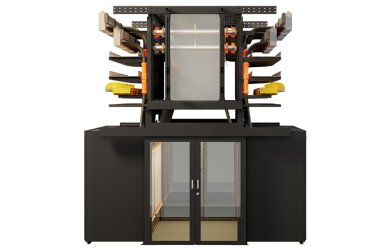
Toshiba Electronics Europe GmbH (Toshiba) announces its next-generation S300 Pro Surveillance Hard Disk Drives (HDDs) targeting the latest requirements in the surveillance storage market.
With capacities up to 10TB[1] and double the buffer size[2], the upgraded HDDs with conventional magnetic recording (CMR) technology enable surveillance system integrators, system installation providers, and end users to record, store and analyse their video streams from up to 64 high-definition (HD) cameras[3].
The high scalable, 3.5-inch[4] S300 Pro Surveillance HDDs, with capacity options of 4TB, 6TB, 8TB and 10TB, now support up to 24 bays, making them an excellent fit for large-scale video recording systems, delivering reliable operation even in the most demanding environments. Additionally, compared to the previous generation, the new S300 Pro provides a higher maximum sustained transfer speed of 268MiB/s[5] and doubles the cache buffer size to 512MiB[6]. The S300 Pro HDDs also reduce power consumption, delivering improved total cost of ownership (TCO).
With 24/7 operation, an enhanced annual workload of 300TB[7] and mean time to failure (MTTF) of up to 1.2 million hours[8], the S300 Pro can handle the increasing video analysis demands of mission-critical surveillance footage. The next-generation S300 Pro’s extended warranty period, from 3 to 5 years, demonstrates Toshiba’s high durability and engineering quality of its HDDs[9].
“Specially optimised for large-scale video surveillance operations, where advanced video analytics, face recognition and editing are mission-critical features, Toshiba’s next-generation S300 Pro delivers enhanced performance, durability, and 24/7 reliability”, says Larry Martinez-Palomo, Vice President, Head of Storage Products Division, Toshiba. “The next-generation S300 Pro Surveillance HDDs demonstrate Toshiba’s commitment to continuously collaborate with industry-leading video surveillance system manufacturers and empower our partners and customers to benefit from our range of high-quality Surveillance HDD portfolio”.
The next-generation S300 Pro Surveillance HDDs will be available in CQ4 2024.
For more information about the next-generation Toshiba S300 Pro Surveillance HDDs, please visit: https://www.toshiba-storage.com/products/s300-pro-surveillance-hard-drive/ .
For more information on Toshiba’s full line of HDD storage products, please visit: https://www.toshiba-storage.com/ .
[1] Definition of capacity: One terabyte (TB) = one trillion bytes, but storage capacity actually available may vary depending on the operating environment and formatting. Available storage capacity (including examples of various media files) will vary based on file size, formatting, settings, software and operating system and/or pre-installed software applications, or media content. Actual formatted capacity may vary.
[2] Compared to the previous generation of S300 Pro Surveillance HDDs: https://www.toshiba-storage.com/products/s300-pro-surveillance-hard-drive/
[3] Number of surveillance cameras support capability is defined by performance simulation with high-definition cameras at 10Mbit/s rate. Actual results may vary based on various factors, including the types of cameras installed, the system’s hardware and software capabilities, the video compression technology used, and system variables such as resolution, frames per second, and other settings.
[4] “3.5-inch“ means the form factor of HDDs. They do not indicate drive‘s physical size.
[5] Read and write speed may vary depending on the host device, read and write conditions, and file size.
[6] A mebibyte (MiB) means 1 048 576 bytes.
[7] Workload is a measure of the data throughput of the year, and it is defined as the amount of data written, read or verified by commands from the host system.
[8] MTTF/MTBF (Mean Time to Failure/Mean Time Between Failures) is not a guarantee or estimate of product life; it is a statistical value related to mean failure rates for a large number of products which may not accurately reflect actual operation. The actual operating life of the product may be different from the MTTF/MTBF.
[9] Operation at a high surface temperature will shorten the drive’s useful life. The recommended operating condition is less than +60°C.
Image Credit: Toshiba





